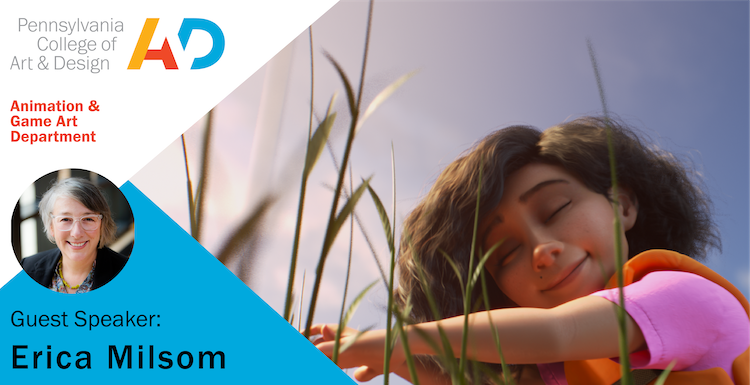
Pixar’s Erica Milsom: ‘I love being told a good story’
Wednesday, January 27th, 2021
Erica Milsom is a storyteller at heart, using film as her medium of choice.
Collaboration, she says, “is the essence of filmmaking.”
On February 1, Milsom, an award-winning writer and director for Pixar Animation Studios, presents an Artist Talk online to the PCA&D community.
A member of the studio’s production team for 2015’s Inside Out, Milsom wrote and directed 2017’s So Much Yellow, an award-winning short film that follows a family in the 1960s making the difficult decision to institutionalize a son who has Down syndrome.
Her most recent animated project, Loop, was part of a Pixar program called SparkShorts, which gives Pixar employees six months and a limited budget to develop short films that explore and expand new storytelling techniques. Released last year on Disney+, Loop is the story of how a non-verbal girl with autism and another teenager learn to connect at summer camp.
It was named Best in Show at last year’s Siggraph competition, an honor that qualifies it as a 2021 Oscar contender.
Get a sneak peek at what motivates Milsom, and a look at her process:
We often talk about art as a way to make connection — as something that can be in service of expressing emotion or ideas. Would you agree that Loop is motivated by that desire, or was it motivated by something else entirely?
EM: I think that once we got going in making the film, the idea of making a connection and evoking emotions through this story took hold. But initially, I was really just looking for a “World” that we could transport the audience into, and after an exhaustive inquiry into worlds that Pixar hadn’t explored … outerspace, innerspace, ummm, the topography of my sidewalk??? I thought, what about places I had been that I’ve never seen on screen in an animated form. And I thought about that place BETWEEN US when we are trying to find a way to connect. I’ve been there, I know how to explore that space, wouldn’t it be cool if we could take the audience with us?
From there, every choice is in service of evoking emotion in the audience. Getting them to understand and feel the emotional state of (“Loop” characters) Renee and Marcus.
What drew you to filmmaking as your medium for storytelling?
EM: I love telling stories, but I think more than that, I love being told a good story. Making films means I’m privy to people’s stories and the process of telling them allows me this space to puzzle out what they mean — to the teller, to the listener, and to me, as the interpreter. I started as an editor in the doc realm, and that meant I got to listen to the longwinded interviews, I got to see the uncut original b-roll, and choose my favorite moments, string them together, and ponder what it all means in the end. In a documentary, you take a huge amount of information, and you winnow it down to something simpler and eloquently conveyed through sound and picture. All the while, you’re listening to the story, again and again, trying to hold yourself to its core truths.
As I moved into fiction, I found that the process of fiction involved a different kind of listening — trying to hear what these new beings you’ve created in your mind have to say. Once you’ve got them telling you their story, it’s a process of finding the most eloquent way to convey their experience of the world on screen. Again, a kind of listening … but this time to your gut. What images and sounds will best convey this story.
I think no matter what kind of project I’m doing, having a career driven by listening to great stories is a real privilege.
